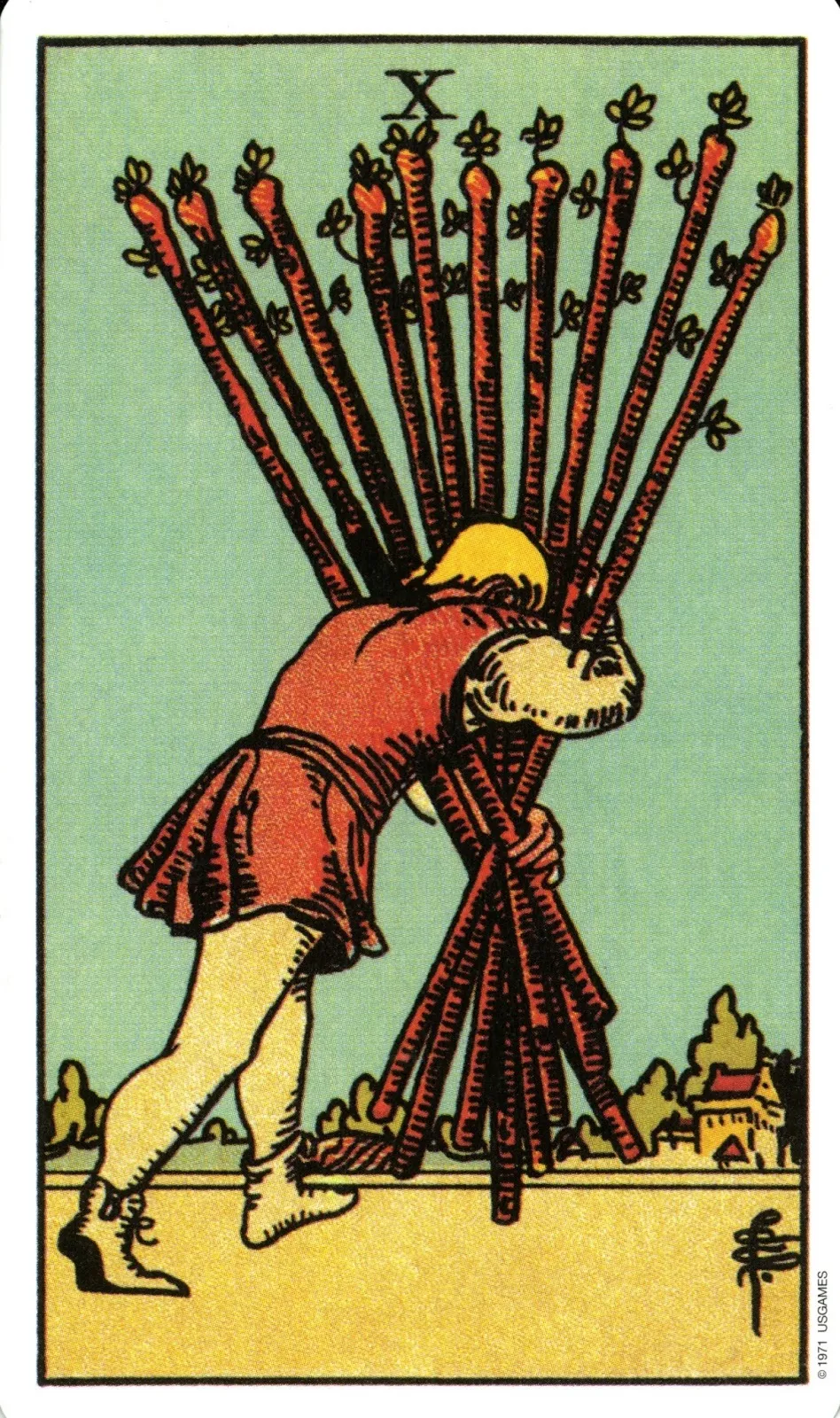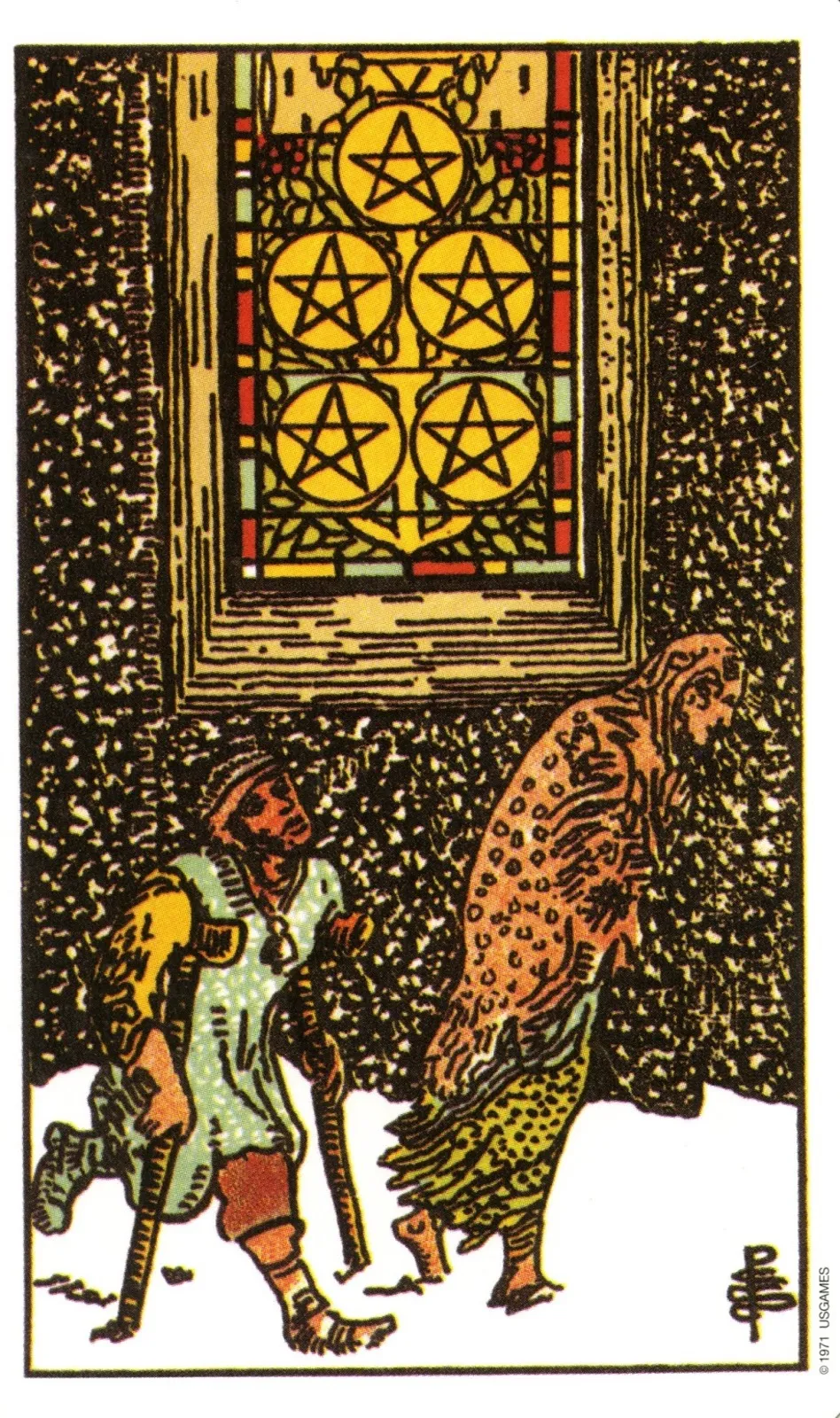Physical pain is often associated with injuries, strain, or medical conditions. However, there are times when discomfort doesn’t stem from any physical cause but rather from our internal emotional and psychological landscape—a concept known as psychosomatic pain. By using tarot as a tool to explore psychosomatic pain, we can gain insight into how unresolved emotions, insecurities, and stressors may be manifesting as physical discomfort in our bodies.
This blog will guide you through the connection between psychosomatic pain and tarot, focusing on specific cards like the Ten of Wands, The Tower, and the Five of Pentacles. Each card offers a symbolic perspective on how shoulder, lower back, and knee pain can reflect burdens, fear of change, and feelings of lack. Through tarot, we can identify these emotional root causes and begin the journey toward both emotional and physical healing.
Table of Contents
ToggleBody Pain and the Emotional Roots of Discomfort
While physical injuries or conditions certainly cause body pain, there are instances when pain is rooted in emotional or psychological distress. This means that our insecurities, worries, and unprocessed feelings can sometimes show up in our bodies as physical symptoms. Our bodies are incredibly intuitive, often sending us signals through discomfort to help us understand that something beneath the surface needs attention.
Example: Leg Pain and Financial Insecurity
Consider leg pain. If you experience frequent discomfort in your legs—whether it’s a dull ache in your calves or strain in your thighs—it might be worth exploring whether you’re feeling uncertain about your stability in life, such as financial security or career direction. These insecurities about the future may manifest as an inability to move forward smoothly, symbolized by discomfort in your legs. This pain can represent emotional “weight” or stress that your legs are metaphorically carrying for you.
Lower Back Pain and Anxiety
Lower back pain is another common complaint that’s often linked to psychological stress, anxiety, and even spiritual disconnection. People who experience chronic lower back pain may be holding onto emotional burdens that affect their sense of grounding and stability. Lower back pain may signal a need to explore aspects of self-worth, fears about life transitions, or unresolved emotions that weigh heavily on your foundation.
Shoulder and Neck Pain: The Burden of Responsibility
Shoulder and neck pain often emerges when we feel overburdened or overwhelmed by responsibilities. If you’re taking on too much without delegating tasks or if you feel the weight of expectations pressing on you, this strain can manifest physically. This pain may be a reminder to reassess boundaries, delegate when necessary, and focus on self-care.
Spiritual and Emotional Pain
Beyond the physical, many people experience a type of pain that comes from a disconnection from self or purpose. This “spiritual” pain can often arise from unresolved emotions, feeling lost in life transitions, or having imbalances in energy (like the root chakra). When our foundation feels shaky, the body and mind often follow suit, signaling that it’s time to ground ourselves and reconnect with our purpose.
How Tarot Cards Can Reveal Underlying Insecurities in Physical Pain?
Tarot can be a powerful tool for understanding the emotional and spiritual dimensions of body pain. Each tarot card holds symbolism that may reveal aspects of our subconscious or offer insights into the hidden sources of our discomfort. Below are some examples of how specific tarot cards may connect to body pain and underlying insecurities.
1. Ten of Wands: Shoulder and Neck Pain – The Weight of Responsibilities
Associated Pain: Shoulder and Neck Pain
Insecurity: Burdened by Responsibilities and Expectations
The Ten of Wands is a powerful symbol of burden and responsibility. It represents the weight we carry when we take on too much or feel pressured by the expectations of others. Shoulder and neck pain often emerge as physical manifestations of this emotional burden. If you frequently feel tension or stiffness in these areas, it could indicate that you are overwhelmed by the demands placed on you, whether from work, family, or other obligations.
This card suggests that you may feel trapped by responsibilities that drain your energy. You might fear disappointing others or failing to meet their expectations, leading to an emotional heaviness that manifests physically in your shoulders and neck. This is your body’s way of signaling that it’s time to reassess your boundaries and prioritize self-care.
Self-Care Insight:
The Ten of Wands invites you to release some of the load you’ve been carrying. Consider what responsibilities are truly necessary and which ones you can delegate or set aside. Taking care of yourself doesn’t mean neglecting others; it means ensuring that you have the capacity to show up fully without being worn down by stress. Practicing mindfulness, stretching, or even getting a massage can help relieve physical tension, while also serving as a reminder to focus on what genuinely matters to you.
2. The Tower: Lower Back Pain – Facing Change and Letting Go
Associated Pain: Lower Back Pain
Insecurity: Fear of Instability and Unexpected Changes
The Tower is a card of disruption, sudden changes, and upheaval. When this card appears, it often symbolizes a need for letting go of old structures and embracing transformation, even if it feels uncomfortable. Lower back pain, in this context, may signal deep-rooted anxieties about instability, a loss of control, or unexpected disruptions in your life. Lower back pain can manifest when you feel as though your foundation is shaky, whether due to financial concerns, family issues, or other life transitions.
The Tower encourages acceptance of change rather than resistance. Lower back pain may serve as a physical reminder that holding onto old fears and insecurities is creating an imbalance. In many cases, this pain reflects a reluctance to embrace the unknown, especially if you are accustomed to being in control. Recognizing and addressing this fear can be a powerful step toward both emotional and physical healing.
Self-Care Insight:
The Tower calls for self-reflection and openness to change. To release lower back pain, consider ways you can build a stronger sense of stability within yourself, regardless of external circumstances. Practices like grounding exercises, meditation, and journaling can help you find a sense of inner security. Acknowledging your fears and working through them rather than resisting change can also ease the tension and pain you carry in your lower back. Embrace the idea that transformation is a part of growth, and letting go of control can bring new opportunities for resilience and self-discovery.
3. Five of Pentacles: Knee Pain – The Challenge of Adaptability and Feeling Unsupported
Associated Pain: Knee Pain
Insecurity: Feeling Unsupported and Struggling with Adaptability
The Five of Pentacles is often linked to feelings of lack, exclusion, and financial struggle. In the context of knee pain, this card suggests that you may feel unsupported or vulnerable, especially when facing challenges that require adaptability and resilience. The knees symbolize flexibility and humility, qualities that help us navigate life’s ups and downs. Knee pain may emerge when we feel isolated or perceive that we are not receiving the support we need to overcome obstacles.
This pain could reflect a deep-rooted fear of inadequacy or an unwillingness to be flexible in challenging situations. You may struggle with accepting help from others or feel that you must face hardships on your own, leading to a sense of isolation that affects your ability to adapt. The Five of Pentacles encourages you to look beyond material or social limitations and recognize that support is available if you are open to receiving it.
Self-Care Insight:
The Five of Pentacles invites you to confront feelings of lack or exclusion and to work on developing a more open and resilient mindset. Addressing knee pain may involve practicing humility and embracing support from others, as well as cultivating inner flexibility. Engage in gentle physical exercises like yoga, which promote joint mobility and flexibility, while also reinforcing mental adaptability. Reflect on whether your sense of self-worth is tied to external factors and work on building a more stable sense of identity that is not reliant on external validation. Learning to accept help and developing flexibility, both physically and emotionally, can help reduce the tension manifesting in your knees.
Using Tarot to Heal and Understand Your Body's Signals
Tarot readings offer a way to explore and understand these physical-emotional connections more deeply. By using tarot to gain insight into our emotional and spiritual state, we can identify the underlying causes of physical pain and begin the process of healing from the inside out. Here’s how tarot can assist in this journey:
- Identify Root Causes: Tarot can reveal the subconscious or suppressed emotions tied to your pain, allowing you to address and process them.
- Offer Guidance for Emotional Healing: Tarot can provide guidance on actions, mindsets, or practices to help release burdens and anxieties.
- Encourage Self-Reflection and Self-Care: Tarot encourages a holistic approach, prompting you to take care of both your emotional and physical health.
A Note on Self-Care and Medical Consultation
While understanding the emotional causes of physical pain is essential, it’s important to recognize that tarot and self-reflection are complementary to, not a substitute for, professional medical care. If you’re experiencing chronic pain, consulting a physician or undergoing physical therapy should be a priority. Tarot readings can serve as a supportive tool for emotional healing, but physical pain may still require medical attention.
Remember: The body and mind work together, and healing often requires a blend of solutions. Exploring both physical and emotional forms of healing offers a more comprehensive path to well-being.
Final Thoughts: Holistic Healing for a Balanced Life
Body pain, in many cases, is the body’s way of signaling that something deeper needs our attention. By exploring the connection between physical symptoms and underlying insecurities or emotional issues, we can gain a better understanding of our whole selves and begin a journey toward true healing.
As you navigate your path, remember that a single solution does not achieve fulfilment. Life is a quest, one that involves tending to both the body and soul. Tarot is one way to support that journey, helping you uncover hidden insights and find peace in mind, body, and spirit.
FAQs
People Also Ask For
Here are some common questions that people generally ask about Health tarot
Yes, emotional issues can often manifest as physical pain. The body and mind are deeply connected, and unresolved emotions, insecurities, or stress can sometimes result in physical symptoms. For instance, stress can lead to muscle tension, while unresolved grief or anxiety can contribute to chronic pain.
Tarot can help by identifying the emotional or psychological causes of physical pain. Certain cards may reveal underlying insecurities or emotional blocks, giving insight into the areas of life that need healing. However, tarot is a complementary tool and should not replace medical advice for physical pain.
No, tarot should not be used as the sole method for treating body pain. While it can offer insights into emotional causes of pain, it is essential to consult with a healthcare professional for any chronic or severe pain. Tarot readings can support emotional healing, but physical symptoms may require medical treatment.
Tarot cards like the Ten of Wands (burden and shoulder pain), The Tower (lower back pain and instability), and the Five of Pentacles (knee pain and feelings of lack) are commonly associated with physical pain. These connections are not definitive diagnoses but provide a symbolic link between emotions and physical sensations.
Yes, tarot readings can support long-term emotional healing by helping you explore unresolved issues and gain clarity on your emotional state. Through self-reflection and deeper understanding, tarot can encourage personal growth, self-awareness, and emotional release, which may positively impact both mental and physical well-being.
Share Post :








